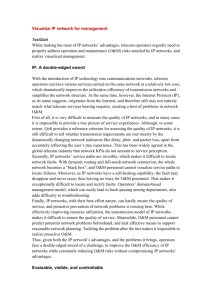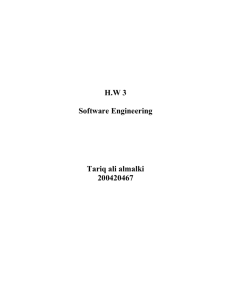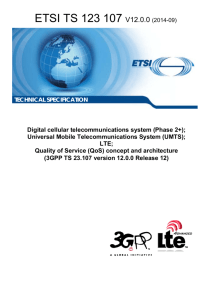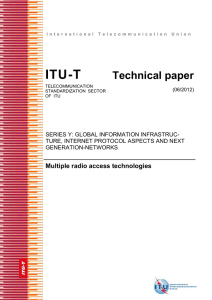O&M in the IP age: Heading for a new direction TextStart Operators
advertisement
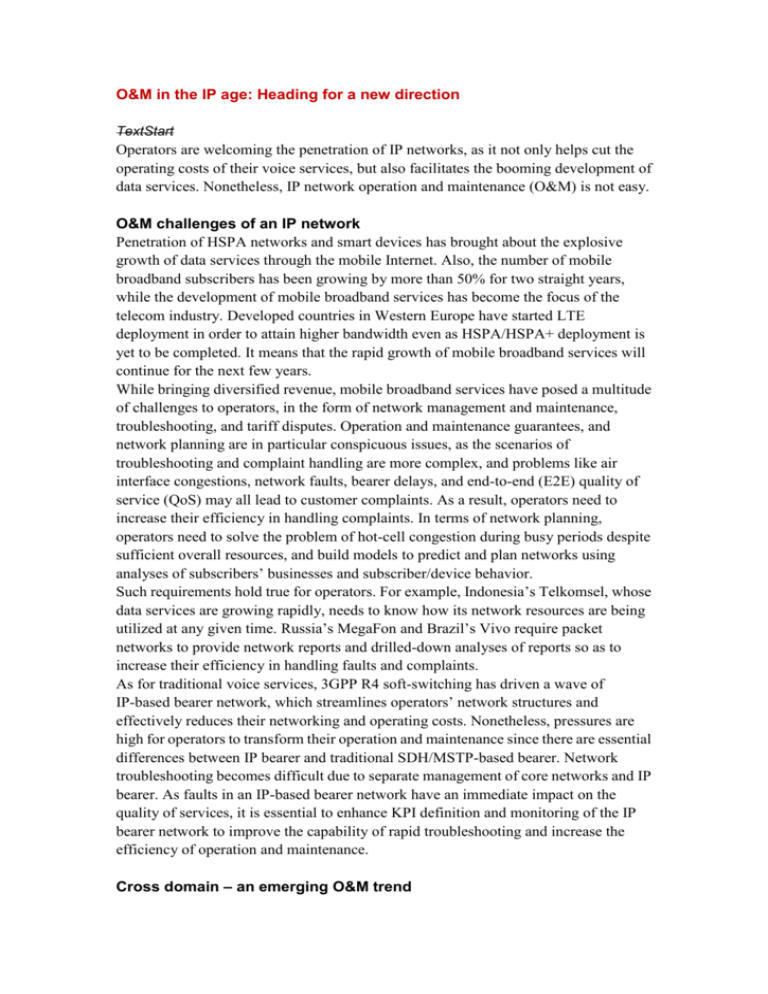
O&M in the IP age: Heading for a new direction TextStart Operators are welcoming the penetration of IP networks, as it not only helps cut the operating costs of their voice services, but also facilitates the booming development of data services. Nonetheless, IP network operation and maintenance (O&M) is not easy. O&M challenges of an IP network Penetration of HSPA networks and smart devices has brought about the explosive growth of data services through the mobile Internet. Also, the number of mobile broadband subscribers has been growing by more than 50% for two straight years, while the development of mobile broadband services has become the focus of the telecom industry. Developed countries in Western Europe have started LTE deployment in order to attain higher bandwidth even as HSPA/HSPA+ deployment is yet to be completed. It means that the rapid growth of mobile broadband services will continue for the next few years. While bringing diversified revenue, mobile broadband services have posed a multitude of challenges to operators, in the form of network management and maintenance, troubleshooting, and tariff disputes. Operation and maintenance guarantees, and network planning are in particular conspicuous issues, as the scenarios of troubleshooting and complaint handling are more complex, and problems like air interface congestions, network faults, bearer delays, and end-to-end (E2E) quality of service (QoS) may all lead to customer complaints. As a result, operators need to increase their efficiency in handling complaints. In terms of network planning, operators need to solve the problem of hot-cell congestion during busy periods despite sufficient overall resources, and build models to predict and plan networks using analyses of subscribers’ businesses and subscriber/device behavior. Such requirements hold true for operators. For example, Indonesia’s Telkomsel, whose data services are growing rapidly, needs to know how its network resources are being utilized at any given time. Russia’s MegaFon and Brazil’s Vivo require packet networks to provide network reports and drilled-down analyses of reports so as to increase their efficiency in handling faults and complaints. As for traditional voice services, 3GPP R4 soft-switching has driven a wave of IP-based bearer network, which streamlines operators’ network structures and effectively reduces their networking and operating costs. Nonetheless, pressures are high for operators to transform their operation and maintenance since there are essential differences between IP bearer and traditional SDH/MSTP-based bearer. Network troubleshooting becomes difficult due to separate management of core networks and IP bearer. As faults in an IP-based bearer network have an immediate impact on the quality of services, it is essential to enhance KPI definition and monitoring of the IP bearer network to improve the capability of rapid troubleshooting and increase the efficiency of operation and maintenance. Cross domain – an emerging O&M trend With the relative separation of bearer and services for IP-based networks, full consideration of network resources at the service level is not possible. For existing network O&M platforms, the management and O&M systems for wireless, core and bearer networks are separate from one another, without a unified platform to look at the entire network from the perspective of services. Simply putting these different network management systems together will only add to the difficulties for O&M engineers, leading to increased interfaces for O&M, a lengthy and complex process as well as blurred boundaries of responsibility. Therefore, cross-domain capability becomes a priority for the development of network maintenance systems. It is aimed at enhancing end-to-end network visibility, focusing on the E2E QoS and upping the end-to-end handling efficiency of faults and complaints. Enhancing network visibility As IP networks are maintained and operated in a greatly different way from SDH/MSTP networks, it is hard for IP networks to inherit the O&M advantages of SDH/MSTP ones. Without visibility into the network operation, the IP network is like a “cloud” to O&M engineers. Nonetheless, carrier-class O&M requires visibility into the mysterious “cloud” so that engineers can see clearly into every route and path and have a view of the QoS status of those paths in a real-time manner, just like they do with traditional SDH/MSTP networks. This represents a big step forward in the shift from passive to proactive O&M. With graphical visibility into “soft” pipelines and maintenance indicators, O&M engineers are able to maintain bearer networks in a predictive way, guaranteeing better support for the bearer of mobile services Focusing on end-to-end QoS In traditional SDH/MSTP-based bearer, factors affecting the QoS were relatively simple, and focus of operators was on network elements (NEs) and wireless coverage, with the O&M goal being to increase the utilization of network resources and the quality of wireless network coverage. With IP networks, however, there are more factors affecting the network quality and the focus shifts toward E2E QoS and user experience. For voice services, factors affecting the QoS could relate to wireless, bearer, and core networks, while quantifiable IP network indicators include packet loss/error rates, jitters, and delays. From the perspective of E2E QoS monitoring and control, operators need to relate those quantifiable IP network indicators with their effects on voice services. For example, the packet loss rate may affect the call complete rate of the corresponding route and also the voice quality. Allowing for end-to-end factors affecting voice quality facilitates objective assessment by the operation and maintenance staff on how to optimize the network. Things become more complex with data services. Given the wide variety of commonly used data services, from MMS, WAP/web browsing, email and download services to currently fast-growing services of IM and mobile video, the impact of quantifiable IP network indicators such as the packet loss rate, jitters and delays on user experience may vary widely from service to service. It is necessary to have service-specific indicators to monitor the QoS of each service. Improving the efficiencies of faults and complaints handling There are three major methods to improve the efficiency of fault handling. Firstly, prevent the occurrence of faults proactively with the aid of enhanced centralized monitoring/control. Leverage the visibility into the network to monitor the usage and operation status of network resources and secure real-time view of the QoS trend through end-to-end service management. Furthermore, with the help of information such as alerts and complaints, increase the ability to prevent network faults upfront. Secondly, increase support for O&M experts using IT systems. Help experts to quickly find out fault cause using Case Library, collected real-time information and the system’s automatic diagnosis. Thirdly, provide solutions for voice quality problems such as one-way calls and crosstalk. Such problems have severe effects on user experience and usually lead to a lot of complaints, yet they tend to be less visible and difficult to diagnose, despite weeks of efforts. Analyzing suspected voice quality problems and monitoring/controlling the voice quality can help increase efficiency greatly. The key here is to move the operation and maintenance expert system upfront, to directly deal with customer complaints and deal with most problems on site through systematic, standardized processes and supporting aids, thereby increasing customer satisfaction. For example, provide onsite guidance for subscribers to correct configurations through call signaling process recall and automatic analysis. SmartCare: A new way of operation and maintenance Huawei provides operators with its SmareCare solution, which addresses cross-domain challenges with a unified platform and an open architecture. It satisfies requirements for increasing the efficiency of operation and maintenance through enhanced smart analysis; it supports the collection of various data and enables end-to-end network visualization through the collection and comprehensive analysis of information on wireless, core and bearer networks. It features QoS monitoring/control and guarantee at the service and subscriber levels through powerful data analysis. With our rich experience in network operation and maintenance, we offer you highly intelligent solutions for handling network faults and complaints. Service perspective on IP network to clearly present end-to-end paths: SmartCare solution supports active detection and passive monitoring and real-time access to QoS status information on IP network routes and paths, and leveraged data submitted by probes and network administrators as well as joint analysis of the operation status of wireless, core and bearer networks to enable end-to-end IP network visualization. Building KQI systems to make QoS measurable: SmartCare solution has KQI systems in place for important services such as voice, SMS, MMS, WAP, web browsing, download, email, IM and streaming, enabling measurement and assessment on the quality of services as well as monitoring/control over the end-to-end network operation status from the perspective of services. Experience sharing to increase the efficiency of fault and complaint handling: To support fault and complaint handling, SmartCare solution saves at least seven days’ worth of data on network operation. It enables quick query and location of network data about a fault, including call records and detailed signaling process, after receiving a fault alert or request for handling a complaint. Through automatic analysis of those data, it can quickly identify the problem or narrow down possible root causes into a smaller field, leading to a significant increase in efficiency for handling faults and complaints. In addition, SmartCare offers operation and maintenance Case Library, through which the operation and maintenance staff are able to solve most problems quickly after receiving alarm or complaint tickets. Since its inception, Huawei’s SmartCare solution has been well received in the market. Taking the local network of China Mobile Guangdong for example; Two cases of negative impact of local IP network faults on services were successfully avoided through the active prevention and alert function provided by the system and timely adjustment to network configurations within six months after it employed Huawei’s IP network visualization solution in early 2010. TextEnd




